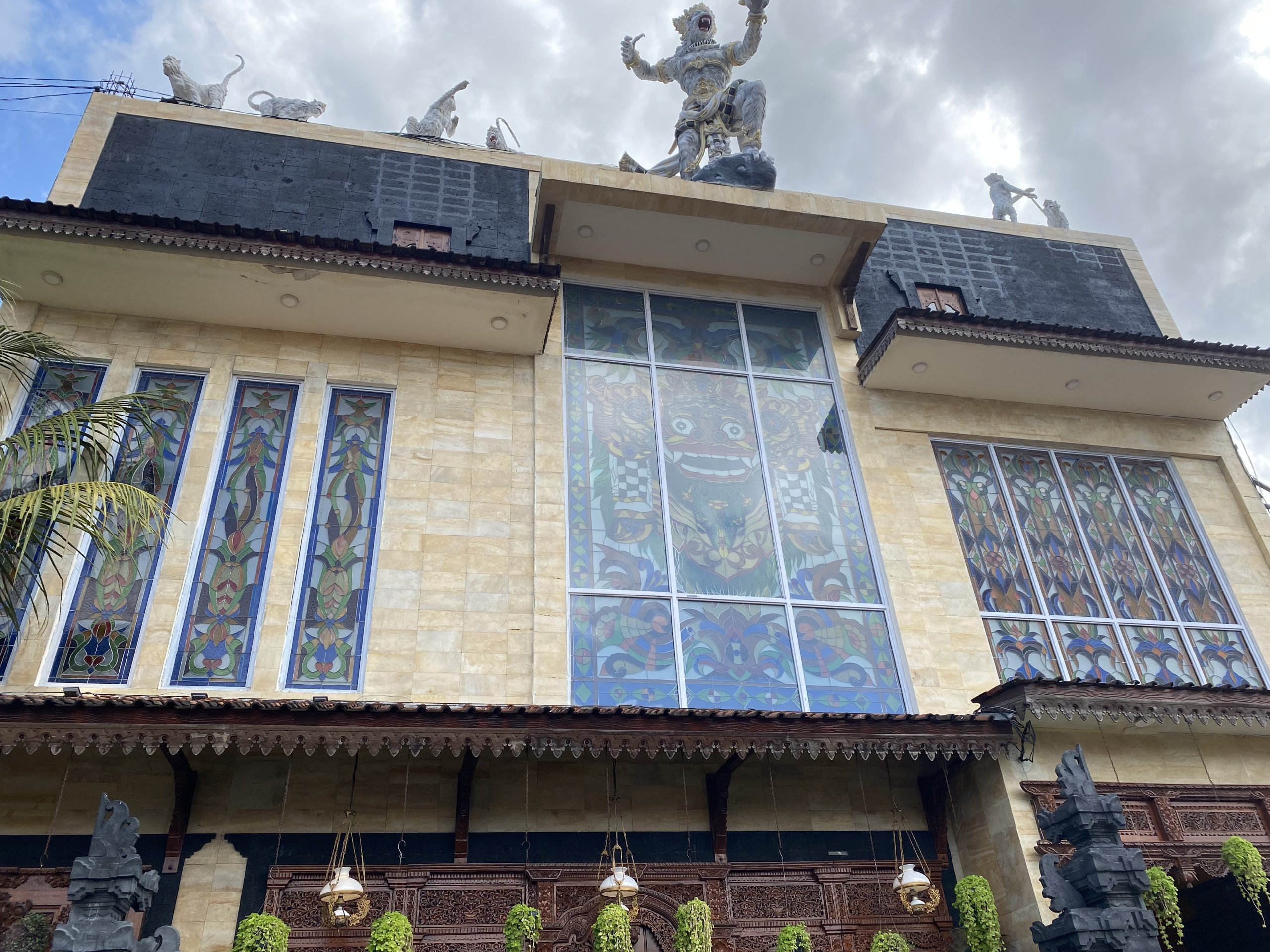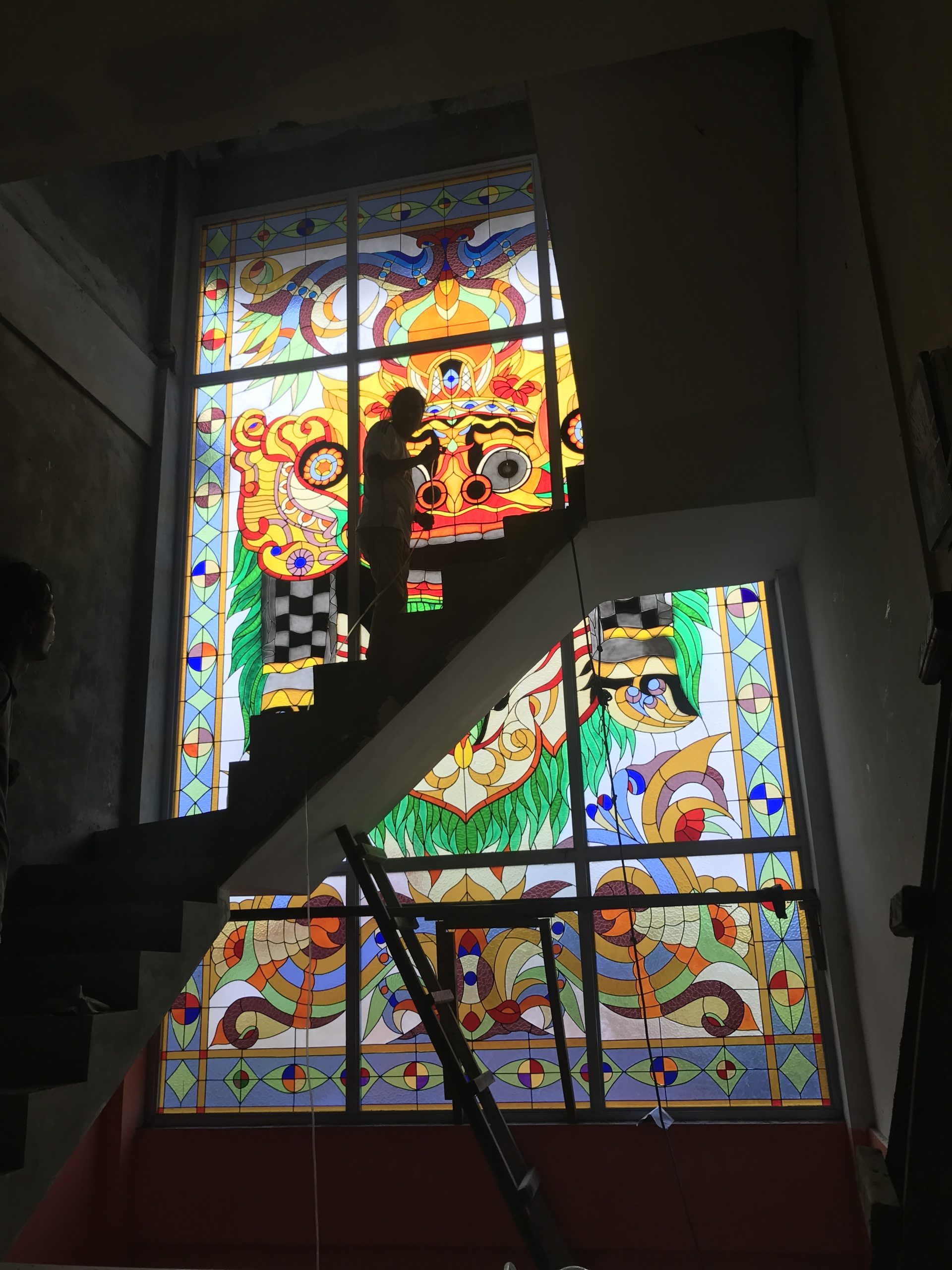I'll never forget the first time Mr. Lex Santoso showed me the space. Standing in his antique museum in the heart of Ubud, I looked up at the towering 5-meter windows that would become the centerpiece of his collection. "These windows must tell the story of Bali," he said with that characteristic twinkle in his eye. What followed was one of the most challenging, spiritually profound projects of my career—a journey to capture the essence of Barong in stained glass, a project that would test our technical limits and deepen my understanding of Balinese culture.

Meeting Mr. Santoso's Vision
Mr. Santoso isn't just a collector—he's a guardian of Balinese heritage. His museum houses one of the most significant private collections of Balinese antiques in the world. When he approached us in early 2022, he had a specific vision: monumental stained glass windows that would honor the Barong, the mythical creature representing the king of the spirits and protector against evil.
I remember sitting with him in his garden, surrounded by centuries-old masks and carvings. "The Barong isn't just a symbol," he explained, "it's the embodiment of Balinese spirit—fierce yet benevolent, ancient yet ever-present." He wanted the windows to capture this duality: the Barong's powerful presence while allowing light to flow through like the life force it protects. It wasn't just about creating beautiful glass—it was about creating a spiritual threshold.
Interpreting Barong Symbolism in Glass
Translating Barong imagery into stained glass presented unique challenges. Traditional Barong masks are incredibly detailed—flowing manes, intricate facial patterns, expressive eyes—none of which translate easily to glass at monumental scale. I spent weeks studying ancient masks in Mr. Santoso's collection, sketching, and consulting with local Balinese artists to understand the sacred geometry behind Barong's features.

What fascinated me was how the symbolism informed our technical decisions. The Barong's eyes needed to be the focal point—they represent awareness and protection. We used a special gold-leaf technique for the eyes that catches the light differently throughout the day, creating the illusion that the Barong is watching over the museum. The mane, traditionally representing spiritual energy, became a cascade of flowing glass pieces in varying shades of gold and crimson, designed to create a shimmering effect as light passes through.
The Engineering Challenge of Monumental Scale
Creating 5-meter stained glass windows was unprecedented in Bali. Standard techniques wouldn't work—glass at this scale would be too heavy, prone to warping, and vulnerable to Bali's tropical climate. I remember the sleepless nights worrying about structural integrity while preserving the delicate beauty of the design.
We developed a revolutionary support system that combined traditional lead caming with hidden steel reinforcements. Each window was divided into modular sections that could be installed separately yet appear seamless. The real breakthrough came when we discovered a way to curve the glass subtly, following the natural contours of the Barong's form while adding structural strength. This wasn't just engineering—it was sculpting with light and strength.
Key Elements of the Barong Design:
- Sacred Geometry: Incorporating traditional ukiran (Balinese carving) patterns that carry spiritual significance
- Dynamic Color Palette: Using layered glass techniques to create depth in the Barong's features, with special attention to the traditional red, gold, and black color scheme
- Light Flow Design: Strategic placement of transparent sections to guide natural light through the museum while maintaining the Barong's form
- Symbolic Details: Hidden elements including the kalpataru (cosmic tree) in the background patterns and protective mantras rendered in glass
- Environmental Integration: Designing the glass to interact with Ubud's changing light conditions throughout the day and year
Installation Day: A Cultural Moment
The installation day was unlike any other project I've worked on. Mr. Santoso insisted on a traditional melukat (purification ceremony) before we began. I watched as offerings were placed at the base of each window frame, and a priest chanted prayers for protection and blessing. The entire neighborhood seemed to gather—local artisans, museum staff, even tourists who had heard about the event.

As we lifted the first massive panel into place, something extraordinary happened. The late afternoon sun hit the glass at just the right angle, casting the Barong's shadow onto the museum floor in perfect alignment with an ancient stone carving below. Mr. Santoso's eyes filled with tears. "This is why we do this work," he whispered. "The ancestors are welcoming the Barong home."
What most people don't realize is that these windows change with the time of day. In the morning, the Barong appears serene and protective. By midday, the light creates a dynamic, almost dancing effect in the mane. And in the late afternoon, the setting sun transforms the entire museum into a warm, golden sanctuary. It's not static art—it's living, breathing light.
The Museum Today: A Living Cultural Space
Two years after completion, the museum has become a pilgrimage site for those interested in Balinese culture. Visitors often sit for hours watching how the light interacts with the glass, creating ever-changing patterns throughout the day. Mr. Santoso tells me that many visitors report feeling a sense of calm and protection when standing before the windows—something he attributes to the spiritual energy captured in the design.
What touches me most is how the windows have become part of Ubud's cultural fabric. During the Galungan festival, when Balinese celebrate the victory of dharma over adharma, the museum hosts special ceremonies in front of the Barong windows. I've seen elders point out to children how the glass captures the same spirit as the traditional Barong dance they perform in the streets.
For me, this project was a reminder that glass isn't just a material—it's a medium for storytelling, for preserving culture, for creating spaces where the sacred and the everyday intersect. Every time I visit the museum (which is often, as Mr. Santoso has become like family), I see something new in those windows. They've taken on a life of their own, evolving with the light, the seasons, and the people who experience them.
Your Cultural Story in Glass
Creating the Barong windows taught me that the most meaningful glass work doesn't just decorate a space—it becomes part of its spirit. Whether you're preserving cultural heritage or creating something new, glass has the power to transform ordinary spaces into places of meaning and connection.
Every space has its own story waiting to be told through light and color. Just as the Barong windows have become a living part of Ubud's cultural landscape, your space can become a testament to what matters most to you.
Begin Your Cultural Glass Journey